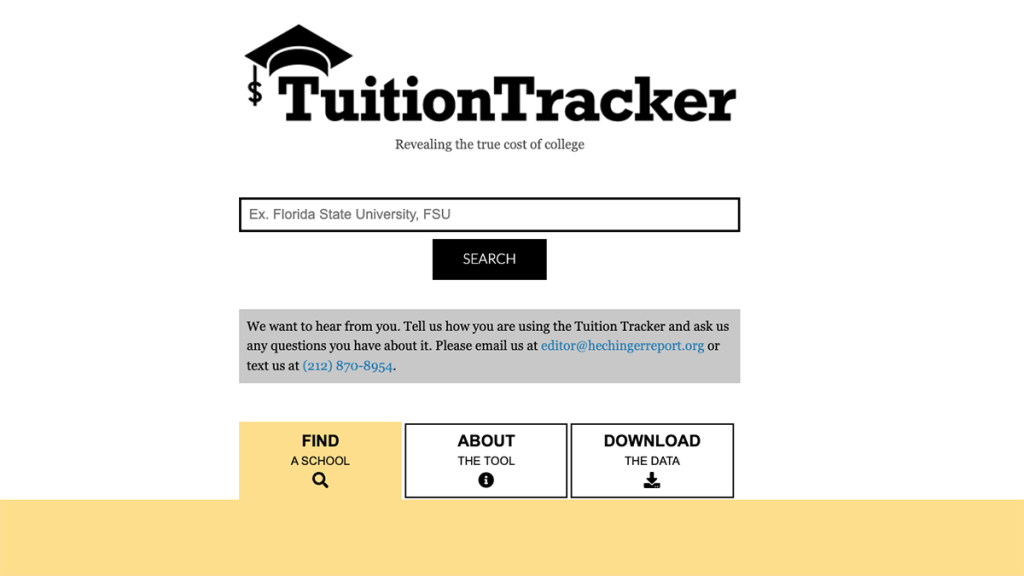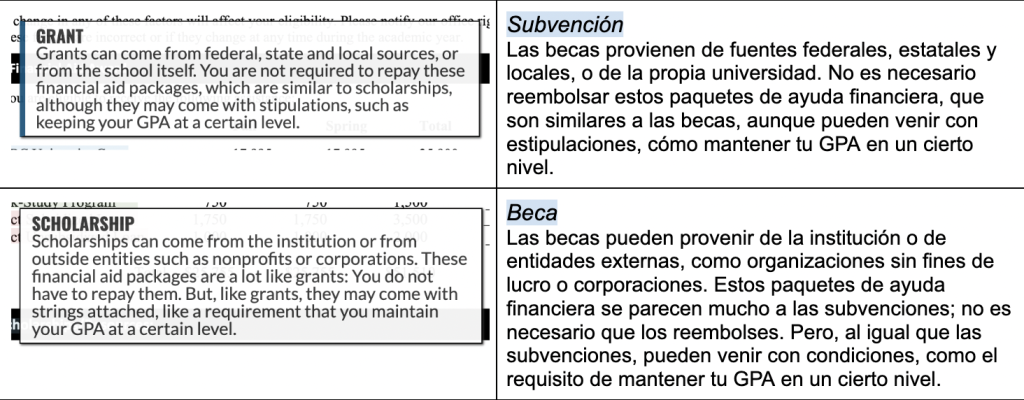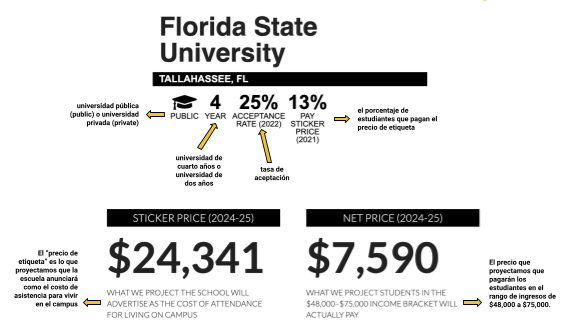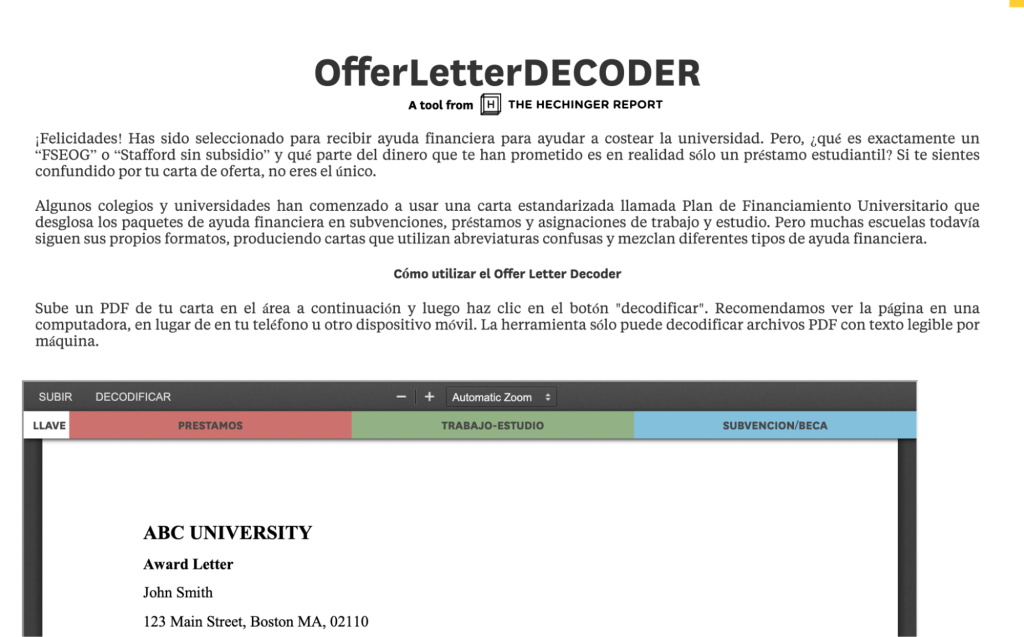
The Hechinger Report offers a tool called Tuition Tracker, which the news organization plans to recreate in Spanish for Spanish speaking communities.
Creating news products for multilingual communities
Early lessons from rethinking our Spanish-language engagement strategy
Scout Hudson is a 2024 RJI Student Innovation Fellow partnered with The Hechinger Report. The RJI Student Fellows will be sharing their innovative work throughout the summer in Innovation in Focus.
The Hechinger Report, a nonprofit newsroom covering issues of inequality and innovation in education, published its first Spanish-language piece on Hechinger en Español in early 2019. Currently, The Hechinger Report translates one or two written stories each month into Spanish and publishes the pieces with a Spanish-language publication. Previous partners have ranged from national outlets, including Telemundo and The Independent, to nonprofits like Palabra and local outlets such as La Voz Chicago.
In surveying our current efforts, we identified our first guiding question: should we turn our focus to strengthening our internal audience (Hechinger en Español site readers) or optimizing our output to readers of our stories in partner publications and other channels?
We chose to turn our focus outward. Here’s how we made that decision and began translating our news products to reach and engage with more Spanish-speaking students, families and educators.
Looking at the numbers
The Hechinger Report tracks engagement through a host of tools including Parse.ly, Google Analytics 4, Stacker Studio, NewBreak and Moz.
Readership metrics on Hechinger en Español site stories were leagues lower than their English counterparts. Site wide, readers spend an average of 1:55 minutes engaged with a post. Of a sampling of eight English stories selected for translation, they similarly averaged 1:39. Meanwhile, their translated versions on Hechinger en Español received 0:41.
These figures indicated that readers were not engaging with translated copy — if fact, the engagement time should be higher on the translated articles since the Spanish copy is often lengthier than the English versions. This inspired us to think about ways to connect with Spanish-language readers outside of our already established channels.
Your team’s capabilities
If your newsroom has yet to explore multilingual content, consider why not. These reasons can help you identify potential barriers in beginning to publish multilingually.
Is there someone in our newsroom that’s a native speaker who might be excited to do this work? Or does this project require a new hire? Or can it be integrated into current workflows by removing other tasks that are less vital?
We circulated early ideas of launching a WhatsApp channel specifically for Hechigner’s Spanish language coverage. However, we felt that we were not translating content frequently enough to populate a channel. Since WhatsApp does not yet have schedule-send capabilities, a channel would require the regular effort of an already busy journalist. The required lift didn’t seem sustainable. Additionally, a channel didn’t align with our goal of engaging audiences outside of The Hechinger Report’s current reach if we didn’t have the ability to keep a steady stream of new information added to the channel.
Tying it to audience needs
A handful of our Spanish-language publication partners shared with us that the length was often a barrier for republication. This prompted us to start thinking about products that weren’t translated articles.
We are currently working to create a Spanish version of two of The Hechinger Report’s interactive tools: Offer Letter Decoder, which allows students to view a categorized explainer of their financial package, and Tuition Tracker, which compares historical data of university’s sticker price with the average price actually paid by students.
These two tools receive consistently high engagement. The English-language version of Tuition Tracker garnered over 2.7 million views in 2023, with a 10.4% growth since 2022. The average engagement time on the tool is 6:58 minutes.
We knew from Moz analytics that public libraries, among other institutions, had already incorporated the tool into their online resource guides. Inbound linking also demonstrated that educators have included the Tuition Tracker into their curriculum and reference materials. We quickly identified high school students, their families and educators as the primary audience of the tool, and conversely, their Spanish-speaking counterparts as a subset of this audience that was unable to access the tools.
According to the National Center for Education Statistics, over five million or 10% of the total number of students enrolled in public primary and secondary schools are designated as English language learners. That’s a 13% increase since 2011, and the National Education Association suggests that one in four students will be an English learner by 2025. We see the growing demand for language-accessible resources and understand the importance of reaching these students.

We thought about product design in terms of lift — what options would require the highest and the lowest amount of labor? What designs could be self-sustaining or require the least amount of upkeep?
Expanding Offer Letter Decoder and Tuition Tracker into Spanish-language products allowed us to design new products off an existing framework.
We used the MoSCoW prioritization framework, created by Dai Clegg, to determine what the most critical needs of our tools are. MoSCoW is broken down into four levels of need: must-have, should-have, could-have, and won’t have yet.
Off this framework, we initially decided to create language compatible guides in place of a fully translated website. These guides would be available to download in users preferred language, and provide instructions for how to navigate the English interface and interpret each element. For example, where the website displays English text, the guide would show a 1:1 translation in Spanish.

Conversations with community stakeholders — such as college readiness coordinators or professionals who work with English Language Learners — emphasized the importance of a fully navigable website in Spanish instead of a supplementary tool in broadening accessibility.
This directed our focus away from compatible language guides to making a fully translated version by mirroring the English version. In the mirrored version, the tool will function the same, but all of the language elements will be displayed in Spanish instead of English.

Incorporating feedback
To ensure the product is useful in addressing our spanish speaking community’s needs, we are building feedback mechanisms into the design process and into the final product. These include:
- We are scheduling meetings with administrators in districts with large populations of multilingual students, libraries we’ve identified as using our tools and nonprofits dedicated to increasing education opportunities, especially for marginalized communities.
- We are holding a focus group with students to better understand their needs in preparing to finance college and their impressions of the Spanish-language tools’ prototypes.

The Hechinger Report is also considering placing call-outs under the copy of our current Spanish-language articles and at the bottom of our newsletters, to learn more about how people are using these tools.

Sign up for the Innovation in Focus Newsletter to get our articles, tips, guides and more in your inbox each month!
Cite this article
Hudson, Scout (2024, July 1). Creating news products for multilingual communities. Reynolds Journalism Institute. Retrieved from: https://rjionline.org/news/creating-news-products-for-multilingual-communities/
